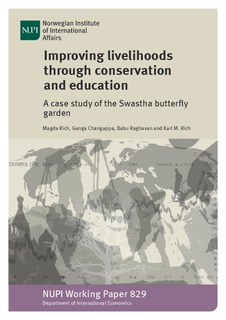Improving livelihoods through conservation and education / Magda Rich, Ganga Changappa, Babu Raghavan and Karl M. Rich A case study of the Swastha butterfly garden
| dc.contributor.author | Rich, Magda | |
| dc.contributor.author | Rich, Karl M. | |
| dc.contributor.author | Changappa, Ganga | |
| dc.contributor.author | Raghavan, Babu | |
| dc.date.accessioned | 2014-11-27T20:41:57Z | |
| dc.date.accessioned | 2015-02-16T14:56:33Z | |
| dc.date.available | 2014-11-27T20:41:57Z | |
| dc.date.available | 2015-02-16T14:56:33Z | |
| dc.date.issued | 2014 | |
| dc.identifier.uri | http://hdl.handle.net/11250/276414 | |
| dc.description.abstract | Abstract In many parts of the developing world, those with physical or mental handicaps are often considered to be a burden on society, with limited to no remunerative activities available in the workforce. Activities such as butterfly farming, which require precision and attention to detail, are potentially relevant for disadvantaged groups as a source of livelihoods. At the same time, such activities can be integrated with community-led conservation efforts as well. We provide a case study of the development of a butterfly garden at the Swastha Centre for Special Education and Rehabilitation in the Kodagu area of Coorg, a region in the state of Karnataka in India through which conservation-based activities are integrated with special education in a manner than builds skills, improves livelihoods, and serves as an important resource for environmental education. Our case demonstrates a scalable means by which butterflies can be used to educate, improve the environment, and offer livelihoods to the disadvantaged in a country where such opportunities are greatly needed. | |
| dc.language.iso | eng | nb_NO |
| dc.publisher | NUPI | nb_NO |
| dc.relation.ispartofseries | NUPI Working Paper;829 | |
| dc.relation.ispartofseries | NUPI Working Paper;829 | |
| dc.title | Improving livelihoods through conservation and education / Magda Rich, Ganga Changappa, Babu Raghavan and Karl M. Rich A case study of the Swastha butterfly garden | nb_NO |
| dc.type | Research report | nb_NO |
| dc.date.updated | 2014-11-27T20:41:57Z | |
| dc.source.pagenumber | 24 p. | nb_NO |
| dc.identifier.cristin | 1178086 |
Tilhørende fil(er)
Denne innførselen finnes i følgende samling(er)
-
NUPI Working Paper = NUPI Notat [304]
ISSN 0800-0018 -
Publikasjoner fra Cristin - NUPI [1400]
